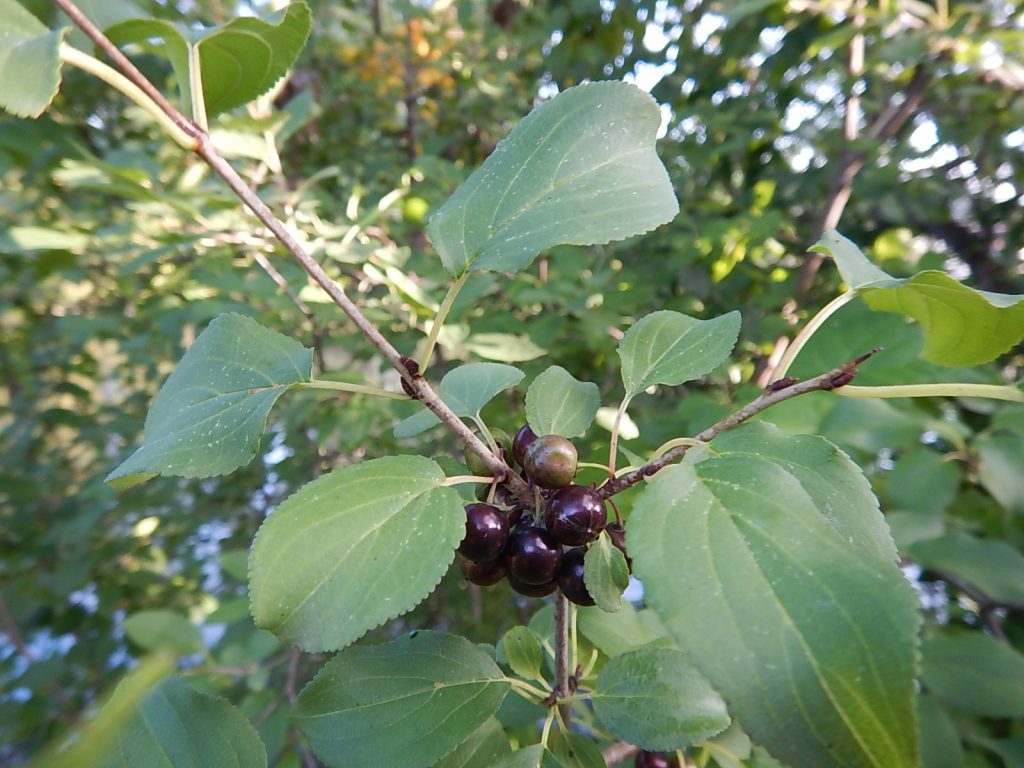X
CONTACT US
Great Lakes Center, SAMC 319
SUNY Buffalo State
1300 Elmwood Ave., Buffalo, NY 14222
wnyprism@buffalostate.edu
(716) 878.4708
SUBSCRIBE TO LISTSERV
FOLLOW US
CONTACT
Common Buckthorn
COMMON NAME:
Common BuckthornSCIENTIFIC NAME:
Rhamnus catharticaORIGIN:
EurasiaDESCRIPTION:
Common buckthorn is a deciduous shrub, or small tree, that can grow up to 25 ft in height. Bark is dark gray while inner bark is orange. Twigs often have sharp spines at the tips. Leaves are smooth and finely toothed with uneven veins stretching towards the tip of the leaf. Flower in the spring (yellow-green, 4-petaled flowers in clusters of 2- to 6) and produces dark purple or black berries. Glossy buckthorn is a similar species.HABITAT:
Common buckthorn will establish in a wide-range of habitats including forests, forest edges and open fields, and will tolerate dry to wet-mesic soils. Common buckthorn is most often found in areas drier to those frequented by glossy buckthorn.THREAT:
Common buckthorns grow rapidly and are prolific seed producers. They leaf out early in the spring and retain their leaves longer than many native plants. They grow into dense thickets, displacing native under-story plants and shading tree seedlings. Leaves are quick to decompose, altering soil composition and pH. Invasive shrubs, including common buckthorn, have been shown to decrease insect diversity and biomass, and have additional negative impacts on native bird species including malnutrition (due to the poor nutritional value of berries) and increased nest predation (due to the high density of shrubs).MANAGEMENT:
Management options for buckthorn may include manual, mechanical and chemical removal. Seedlings and smaller shrubs may be hand-pulled or dug out. Large infestation can be mowed using a forestry mower, in preparation for foliar chemical treatments. Effective herbicide treatments include foliar, basal bark, and cut-stump. Follow-up treatment will likely be required. Common buckthorn are prolific seed producers and tend to re-establish via the seed bank, as well as re-sprout, after herbicide treatment. Different herbicides can be more or less effective, depending on timing of application.
WNY PRISM PRIORITY:
Tier 4 - Local Control
NYS Invasive Species Tiers Chart - Tier Definitions
ADDITIONAL RESOURCES:
Common buckthorn is a prohibited species in New York State - for more information on Prohibited and Regulated Species, visit http://www.dec.ny.gov/animals/99141.html.
Native Landscape Alternatives
Ninebark (Physocarpus opulifolius)
Northern Spicebush (Lindera benzoin)
Serviceberry (Amelanchier spp.)
NYS Prohibited and Regulated Species - Part 575:
PATHWAYS OF INVASION:
Common buckthorn was introduced as an ornamental plant and was widely planted across the landscape. Common buckthorn spreads primarily by seed that is transported by birds and humans.
REGIONAL DISTRIBUTION:
Widespread






